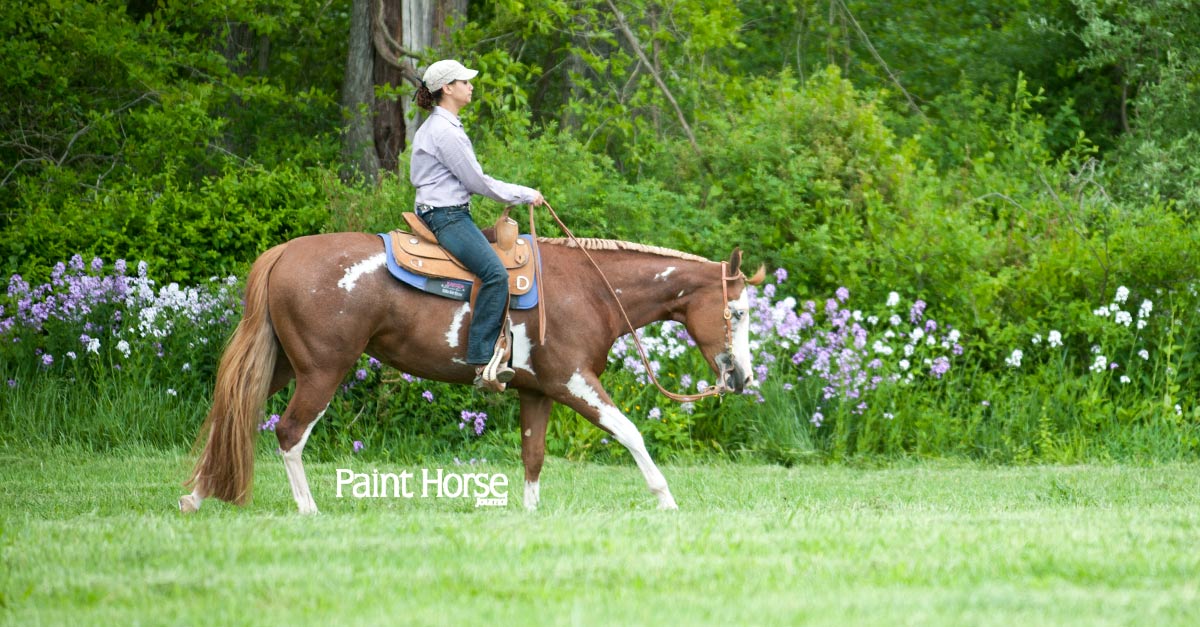Based on its wildly popular series “The Game Plan” in 2014, the Paint Horse Journal enlisted APHA Director of Judges David Dellin to continue The Game Plan as a monthly column this year, shedding even more light on the nuances of judging to help you become a better showman. Following is his column from the March 2015 Paint Horse Journal, which explains the purpose behind calling for extensions and lengthenings of stride in rail classes.
Change of Pace
Something judges are often asked about is the extension of gaits in a Western pleasure class. I would like to clarify a few points on this subject for both exhibitors and judges. Two phrases are often used by judges when these gaits are called. One is the “moderate extension of the jog” and the other is a “lengthening of the stride of the walk or lope.”
The moderate extension of the jog has been used much longer than the lengthening of the stride terminology. A good moderate extension of the jog is defined as a horse who, when asked to extend, has an obvious lengthening in his stride with a slight increase in pace, making him more versatile. This horse is still smooth, but appears to have more length with less effort being exerted. Details about this particular gait are outlined in the 2015 Official APHA Rule Book on page 150. This definition gives us a great mental picture as to what judges want to see when they call for a moderate extension of the jog. It is a place in any exhibitor’s performances when a judge can evaluate that horse’s ability to lengthen its stride.
 If Western pleasure is a foundation class for all other Western events, then a horse being able to change his stride length to maneuver over a set of obstacles or negotiate a pattern is a very important skill. This is also a great opportunity for exhibitors to do two things that can improve their performances: gain good position in the arena and show the judges that they are trying to win. If an exhibitor brings his horse off the rail or maneuvers around other horses—while showing the judge that he has the added control to make such a move while his horse maintains a good topline, expression, cadence and rhythm—then this increases the exhibitor’s difficulty level in that performance. Being able to watch an exhibitor change stride length and pace is very eye-appealing and credit-earning, if it’s done smoothly and with precision.
If Western pleasure is a foundation class for all other Western events, then a horse being able to change his stride length to maneuver over a set of obstacles or negotiate a pattern is a very important skill. This is also a great opportunity for exhibitors to do two things that can improve their performances: gain good position in the arena and show the judges that they are trying to win. If an exhibitor brings his horse off the rail or maneuvers around other horses—while showing the judge that he has the added control to make such a move while his horse maintains a good topline, expression, cadence and rhythm—then this increases the exhibitor’s difficulty level in that performance. Being able to watch an exhibitor change stride length and pace is very eye-appealing and credit-earning, if it’s done smoothly and with precision.
The term “lengthening of the stride” came out of a National Snaffle Bit Association meeting of the top 100 Western pleasure money-earning riders a few years ago. Judges are looking for the same things at the walk and lope that we just described in the moderate extension of the jog. We want to see the horse make some changes to his length of stride. It is very credit-earning when a horse has the ability to show a change in stride length at all three gaits. It also allows judges to evaluate how well those horses are able to maintain their level of control at different paces.
If you read the verbiage that describes “average” gaits for the walk, jog, and lope in the APHA Rule Book, it describes a correct cadence—that’s as simple as a four-beat walk, two-beat jog and three-beat lope. If you are truly doing these three things, then you won’t need to have a huge amount change when you moderately extend the gait, but it will be enough for the judge to see a lengthened stride. If your horse isn’t performing a correct, cadenced gait to begin with, you might really need to step that horse up in order to get to a good extended or lengthened pace.
I believe it is incredibly important to reward horses that can be correct in their gaits, have quality to their movement and have a soft, slow pace. It is also equally as important to not reward a horse that does not have correct cadence at any gait. We as judges should never let a horse that is incorrect in his stride before we ask for an extension beat a horse that is correct in his stride prior to extension, so long as they both extend their gait when called.
As judges and exhibitors, we should look at both the moderate extension of the jog and the lengthening of the stride at the walk and lope as ways to show of our horses’ ability to go on and do other events, like trail and Western riding. If we look at these things as a positive aspect to Western pleasure, then we will be able to move forward with this class and industry in a way that will be much more positive for everyone.
____________
The Paint Horse Journal has continued its commitment as an educational resource in 2015. Last year’s series The Game Plan—which tackled 12 popular APHA events and explained strategies for success from both judges and exhibitors—is now available as a digital PDF through the APHA General Store … or get it FREE when you subscribe, renew or extend your current subscription to the Paint Horse Journal through our special ONLINE ONLY offer. Act fast—this is a limited-time offer.
[Reprinting all or part of this news release is permitted, so long as credit is given to the Paint Horse Journal and a link provided to apha.com.]
About APHA
The American Paint Horse Association is the world’s second-largest international equine breed association, registering more than a million horses in 59 nations and territories since it was founded. APHA creates and maintains programs that increase the value of American Paint Horses and enriches members’ experiences with their horses.





